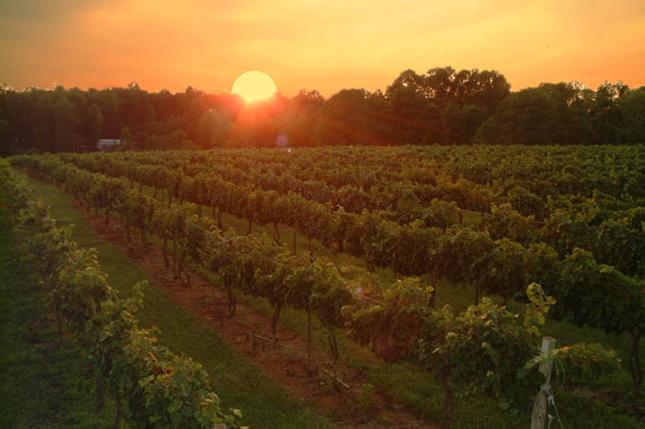People have a rampant misconception that East Coast wines are sweet, simple, and unrefined. They say that our land is not suited for the growth of proper wine grapes. The truth is, we just got a late start.
We are California thirty years ago. The potential has always been there, but not until recently did we begin to pinpoint the “appellations” of the East, and the specific grapes destined to change the tide of Atlantic-coast wine. A rapidly growing contingency of our winemakers produces high-quality dry wines, and the world is beginning to take notice.
The wine revolution, whose ripples are just now reaching our shores, was sparked in Western Europe in the Middle Ages. As winemaking began to spread beyond the walls of monasteries, villages sprung up to support the new agricultural progress. Growers began to recognize which vines flourished under certain conditions, and gradually the viticultural traditions of each growing region became integrally linked to the facets of their developing cultures.
We often take for granted that Burgundy, France is acclaimed for Pinot Noir, or the Rioja region of Spain for Tempranillo, or the banks of the Mosel in Germany for sweet, juicy Rieslings. But there is a centuries-old understanding among winemakers of the dynamic relationship between the vines and the land, summed up by the French word terroir.
Terroir was a foreign concept in the United States until the early 20th century, when California began its own viticultural transformation. Winemakers in Napa realized that hardy Cabernet Sauvignon thrived in their sunny climate, producing intensely bold and tannic wines. A new wave of growers was unlocking the vast potential of their own soil.
These winemakers were pioneers of their era. They ripped out underperforming varietals, planted new rootstocks, tried new pruning methods, aged the wines in American oak barrels, all to produce wine that would rival the best of the Old World.
But it still took generations of experimentation—even one who spends forty years in this pursuit has only forty tries to create their masterpiece, and each vintage inevitably brings new obstacles to conquer.
Not until the 1970s did wine experts begin to view these “New World” wines with unclouded vision. It began with a now-famous blind tasting in which a few Napa wines were rated above their French counterparts. California winemakers, formerly looked down on as hillbilly farmers making lowly table wine, were now revered and respected.
Soon other regions appeared on the scene; by the 1980s the world was singing the praises of Willamette Valley Pinot Noir, New Zealand Sauvignon Blanc, and South African Chardonnay, among many others. And the door was left open for more to follow.
As it would seem, East Coast winemakers are on deck. There has been a great deal of hype in the growing number of wineries in Virginia, Maryland, Pennsylvania and New York. The most prominent frontrunners may be the wineries of the Finger Lake region in New York, who are being recognized for first-rate Riesling and Gewurztraminer.
Simultaneously, the Monticello area of Virginia has been persistently cranking out luscious Viognier and rich Cabernet Franc. And in the Lehigh Valley of Pennsylvania, where I work for a rapidly growing family-run winery, several winemakers have found the Burgundy-like climate to yield lovely Pinot Noir and Chardonnay. A growing number of education programs for enology and viticulture on the East Coast ensure that these wines will only continue to excel in quality.
Yet East Coast wines are still largely considered third-rate (we’ll get into the reasons for that later). Although some individual producers have received notable acclaim, it would be unlikely to spot them in a store or restaurant outside of their state, much less on the Wine Spectator Top 100 list. The only way to combat this trend is to discover for yourself what the East Coast wine country has to offer.
There is a long way to go, but all it takes is a few stellar vintages to ignite the buzz. If you ask me, it won’t be long before “Monticello Viognier” will be as common a phrase as “Napa Cab” or “Australian Shiraz.” Now you can say you saw it coming.
Sip of the Day
Dr. Konstantin Frank Dry Riesling 2009
Available at Calvert Woodley, 4339 Connecticut Ave, N.W.
A vibrant and well-balanced wine from one of New York’s oldest and most renowned producers. With just a touch of residual sugar for softness and body, it’s crisp citrus notes in the front of the palate are followed beautifully with a light but lingering floral finish.
Caroline Jackson is the Assistant Winemaker at Blair Vineyards in Eastern Pennsylvania. She has a degree in English and a background in wine retail. Visit her blog, Sips and Sounds, which pairs daily music selections with a wine or craft beer.


